Love and lost, spirits of the past, awakening the childhood of civilisation, cultural exchange with the distant souls are the topics of Iraqi born Artist Sadiq Toma.
Living in exile in London Sadiq creates a cultural phenomenon connecting with the ancient civilisation of Sumeria and introducing the present.
He studied in the Fine Arts Institute in Bagdad, Iraq and begun his carrier in the arts sector for number of publishing companies and became a well known animator and a painter for children and an Artist at the museum of Bagdad.
Sadiq left Iraq for London in 1978, “The state of Iraq was unstable, intellectuals were being threatened and undesired” says Sadiq with remorse. “I was young and ambitious and when in 1978 Iraq and Iran engaged in war it was a matter of life and death for many” informs Sadiq with regret.
“I didn”t join any political group because I see human beings as independent individuals and I realised there was no turning back hence I left my childhood, my memories of love and lost, my peers and my dreams for a new future in UK” he explains.
It was a great price to pay however being a unique warrior Sadiq repressed his past and begun a new journey in London. Although Sadiq’s visions of the world were always on canvas he started his career as a Graphic Designer and Illustrator for various Arab Press Houses and International Newspapers and Magazines in London.
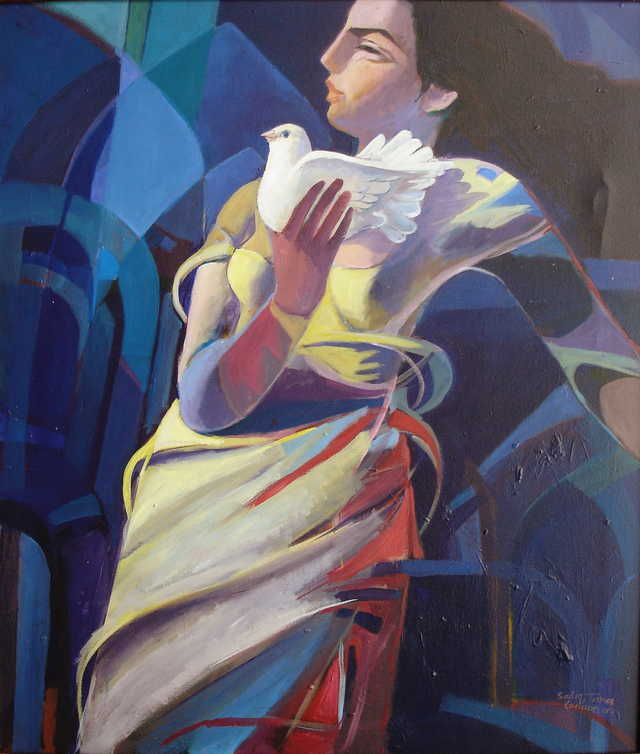 “But after ten years of servicing it was time for me to develop my pain and sorrow, my memories and reality on canvases” says Sadiq.
“But after ten years of servicing it was time for me to develop my pain and sorrow, my memories and reality on canvases” says Sadiq.
Sadiq depicts the lives of ancient Sumeria, known to be the oldest and possibly the beginning of human civilisation. Sadiq is fascinated by the repressed past and has an attraction to archaeological discoveries.
“I am neither an excavator nor an archaeologist and I am not trying to educate the audience” Sadiq warns anxiously. “But cultural exchange with the ancient world brings us close to human feelings, its a way of remembering although we are different as human beings we are all the same, started our journeys from the same beginning,” Sadiq says blissfully.
I am excited by the fossils, skeletons, fragments of clay tablets inscribed with cuneiform writings and paintings on an excavation; I feel there is something about human emotions and the ideas of love and unity can be reinstated in a non condescending way by converting spirits of the past into genres today.” Sadiq gazes at the ancient Sumeria, what the artist believes are the strongest influence on his Iraqi roots.
Sadiq exhibited internationally and discovered how similar human beings are and yet so different. Sadiq’s interpretation of the ancient Sumerian society represents the similarities of human emotions in all ages and societies and yet it reasons our differences in social, cultural and historical structures.
“Understanding differences is about peace and continuing depicting the best in human invention and discoveries to a fairer and universal civilisation” pleads Sadiq.
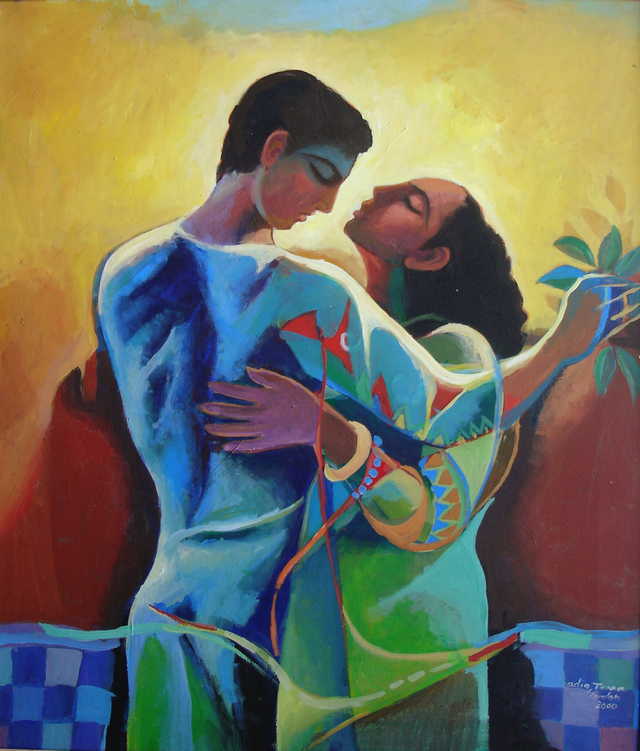 Sadiq pays homage to the childhood of civilisation amalgamating the mysterious past with the present with a series of oil paintings, sketches, printing, sculptures and calligraphies.
Sadiq pays homage to the childhood of civilisation amalgamating the mysterious past with the present with a series of oil paintings, sketches, printing, sculptures and calligraphies.
Sadiq’s depiction of poetry in Arabic text in Calligraphy has a close link with the world, a sense of universal affection and comfort, an adorable but philosophical state of the mind leading the spirit to move forward with the best of creations by humans:
“I depict the past to celebrate the things I love around me, the things I have left behind and my journey to the progress of civilisation” expresses Sadiq.
He prefers to experiment with gel, acrylic, watercolours and oil paints on canvas and his works includes writing on clay or on paper.
“You see it was a party state and it was about Arab Unity” informs Sadiq about Iraq in his youth. “They expected everyone to join and we felt we were forced victims. It was a peaceful state prior 1970s, with all my childhood memories I continuously felt homesick and yet our lives were in threats. I asked myself “what did I do wrong?” Sadiq gazes in the past for an answer.
“I begun a family for a sense of belonging and started to look back not only in my past but at the beginning of civilisation, seeking for an answer of our differences and similarities and what is important.” Sadiq opens an invisible closet as he speaks about his journey.
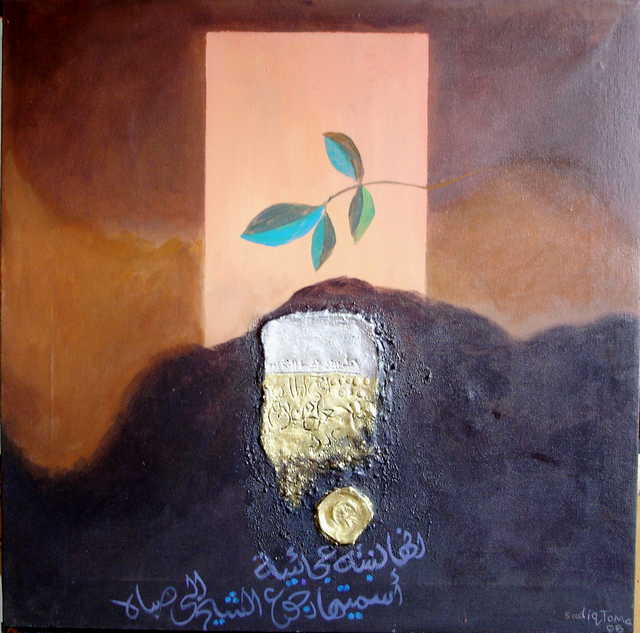 During his MA studies Sadqi started to learn about Sumerian civilisation in ancient Mesopotamia which is now modern Iraq, the birth place of the story of Gilgamesh, our theological world, where the fate of the mortals were first questioned.
During his MA studies Sadqi started to learn about Sumerian civilisation in ancient Mesopotamia which is now modern Iraq, the birth place of the story of Gilgamesh, our theological world, where the fate of the mortals were first questioned.
Sadiq started to visit British Museum and studying Cuneiform writing, the ancient Sumerian Art. And he was fascinated to find how uniformed and progressive this civilisation was.
The Sumerians had schools for children, an organised social and political structure. “This is my past” , Sadiq’s eyes glitters with pride of rediscovering himself.
It is clear that an energy of joy runs through Sadiq’s veins as he explains: “I realised love, affection, scholastics were long born in the very culture I was born into and offered something wonderful to the world already, I realised I don’t have to run far and wide to find an answer, the answer is lying in my past and in my present, the answer his in humanity, its constant pursued of happiness and its labour to find nirvana in earth.”
Sadiq explains his journey with a sense of pain, a sense of losing the past in his exile and all the souls he has left ones.
Sadiq works are homage to his childhood, the memories of flying kite, running under the clear blue Mediterranean sky in his hometown Bagdad, the glittering silver painted waters, fishing with peers, the sweet zephyr under the shady palm trees, mother nature’s toffee treats of sweet dates bunches hanging from the tall and dignified trees inviting innocent eyes, the first kiss and loosing the girl of his dream.
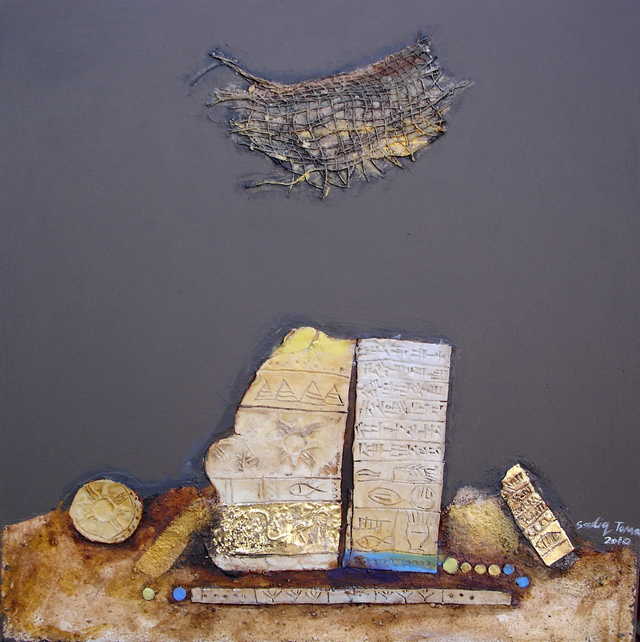 Sadiq pays homage to the past that has been raped and abused by greed and envy and believes the resurrection of the past will deliver a great future.
Sadiq pays homage to the past that has been raped and abused by greed and envy and believes the resurrection of the past will deliver a great future.
“I am paying homage to human feelings and the heritage of human beings. It is not about nationalism or an illustration of the success of a political state but it”s an awareness of all humanity.
I intend to make new images combining the ancient world and the present, I am depicting old and new dreams at the same time and it is not worth trying to find conflicts in deference but finding success in humanity” the optimistic Artist explains.
“The glory of Sumerian Civilisation reminds me that nothing is forever” says Sadiq philosophically; Sadiq’s message to the spectator is” The idea behind it is to acquire humility and keep doing what you can do and be the best you can be as long as you are doing the right thing”. ( The Prisma’ memoirs. Mayo, 2013)
(Images provided by the interviewee and authorised for publication.)

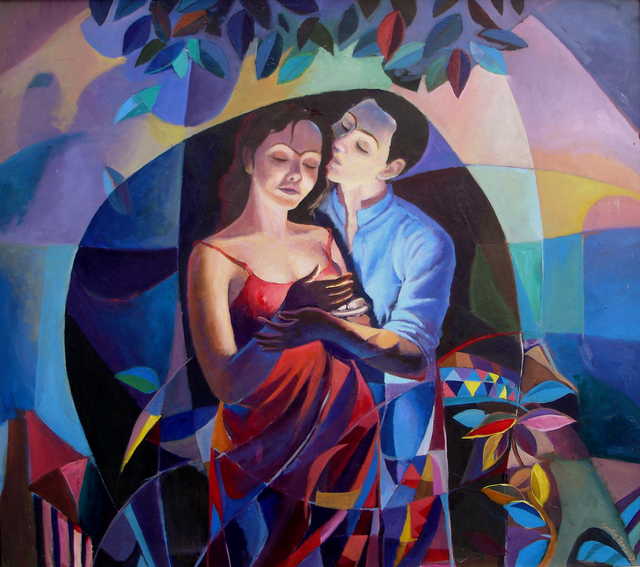











.jpg)












